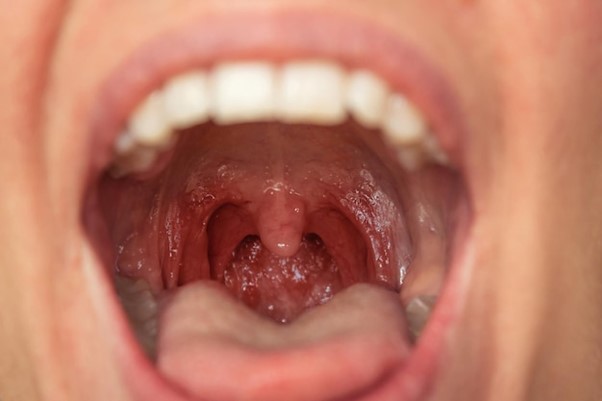Tonsillitis is a common condition that occurs when your tonsils, the two small lumps of soft tissue at the back of your throat, become infected.
It’s most often seen in children and adolescents but can affect people of all ages.
This condition is typically characterized by a sore throat and can sometimes lead to more severe health complications if not managed appropriately.
What is Tonsillitis and How Does it Happen?
Tonsillitis is the swelling of the tonsils, typically caused by viral or bacterial infections. Your tonsils play an essential role in trapping germs and preventing infection, but when they become infected, they can become swollen, red, and painful, leading to difficulty swallowing and other discomforts.
What are the symptoms of tonsillitis?
The symptoms of tonsillitis develop suddenly and can include:
- Sore throat or scratchy sensation in the back of the throat.
- Painful swallowing or difficulty eating and drinking.
- Red, swollen tonsils with possible white spots or coating.
- Fever above 100.4°F (38°C).
- Swollen lymph nodes on either side of your neck.
- Stomach aches or vomiting (common in younger children).
The pain and discomfort usually prompt individuals to seek medical attention for relief. If you notice these signs, it may be time to consult with a healthcare provider.
What Causes Tonsillitis?
Tonsillitis is typically caused by viral or bacterial infections.
- Viral tonsillitis: Viruses, such as those that cause the common cold or flu, are responsible for the majority of tonsillitis cases (up to 70%). Symptoms tend to be milder and typically improve within a week without the need for antibiotics.
- Bacterial tonsillitis (Strep throat): This form of tonsillitis is caused by Group A Streptococcus bacterium. It often results in more severe symptoms and requires antibiotics for effective treatment. Even without tonsils, a person can get strep throat, as it affects the throat area.
How does tonsillitis spread?
Both viral and bacterial tonsillitis are contagious and spread through:
- Kissing or sharing eating utensils.
- Close contact with infected individuals.
- Inhalation of droplets from sneezing or coughing.
- Touching contaminated surfaces and then touching your face.
Children, especially those between the ages of 5 and 15, are at a higher risk of developing tonsillitis. However, individuals in environments with frequent exposure to others (like schools or daycare) are also more likely to encounter the germs that cause it.
How is Tonsillitis Diagnosed?
To diagnose tonsillitis, doctors typically perform a thorough examination, looking for visible signs of infection such as redness, swelling, and pus on the tonsils. Your doctor may also check for other symptoms such as fever, rash, or swollen lymph nodes.
Tests to confirm tonsillitis: To determine whether the infection is viral or bacterial, your healthcare provider may conduct a throat culture. This involves swabbing the back of your throat with a cotton swab to collect cells for testing.
If Group A Streptococcus bacteria are found, you’ll be diagnosed with strep throat (bacterial tonsillitis). If no bacteria are found, your tonsillitis is most likely viral.
How is Tonsillitis Treated?
Treatment for tonsillitis depends on its cause.
- Viral tonsillitis: For viral tonsillitis, antibiotics aren’t needed. Treatment generally focuses on relieving symptoms with pain relievers, warm liquids, saltwater gargles, and throat lozenges. Rest and fluids are crucial for recovery.
- Bacterial tonsillitis (Strep throat): Antibiotics, are prescribed to treat bacterial tonsillitis. It’s important to complete the full course of antibiotics as directed, even if you start feeling better before finishing the medication.
- Surgical treatment: If you experience chronic tonsillitis or recurring infections, your doctor may recommend a tonsillectomy — the surgical removal of your tonsils. This is typically reserved for those who have frequent or severe tonsil infections.
How Can Tonsillitis Be Prevented?
While you can’t entirely prevent tonsillitis, there are measures you can take to reduce your risk of getting it:
- Practice good hygiene: Regularly wash your hands, especially before touching your face, nose, or mouth.
- Avoid sharing personal items: Don’t share utensils, cups, or food with someone who’s sick.
- Disinfect surfaces: Frequently clean items like your toothbrush (replace every 3 months or after illness) and shared surfaces in your home.
- Stay away from sick individuals to reduce the risk of exposure.
For those with frequent infections, especially children, it’s important to maintain good hygiene practices and avoid close contact with others who may be ill. Early diagnosis and treatment are key to preventing complications like obstructive sleep apnea, tonsil stones, and infections that may spread to other parts of the body.
When Should You Seek Medical Attention?
Tonsillitis generally resolves within a few days, but you should consult your doctor if:
- Your fever exceeds 101°F (38.3°C).
- Severe pain or difficulty swallowing makes it hard to eat or drink.
- Your sore throat lasts for more than four days without improvement.
- Difficulty breathing or swallowing occurs.
- You notice swelling or severe pain in your neck or jaw.
Tonsillitis can lead to complications like peritonsillar abscesses, rheumatic fever, or post-streptococcal infections, so it’s crucial to address it early.
Conclusion: Get the Expert Care You Need at Asian ENT Care Centre
At Asian ENT Care Centre, we understand how painful and disruptive tonsillitis can be. Whether your child is suffering from frequent throat infections or you’re experiencing a sore throat yourself, our expert team offers comprehensive care to diagnose and treat your condition effectively. Don’t wait — get relief from your tonsillitis today!
Contact us now to schedule an appointment or learn more about how we can help you recover quickly and safely.



